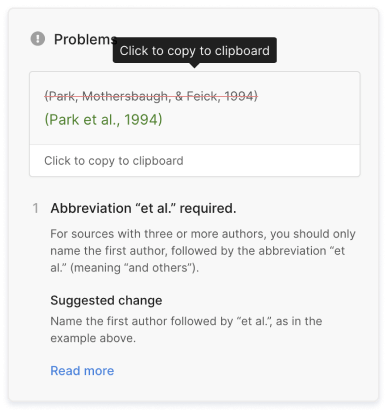Et Al. | Meaning & Use in APA, MLA & Chicago
“Et al.” is short for the Latin term “et alia,” which means “and others.” It is used in academic citations when referring to a source with multiple authors.
Different citation styles have different rules for when to use “et al.” Below, we explain the rules for APA, MLA, and Chicago style.
Using et al. in APA Style
APA Style has slightly different rules for using “et al.” depending on whether you’re following the 6th or 7th edition.
7th edition rules
In APA 7 in-text citations, when a source has two authors, list both. When there are three or more authors, cite the first author followed by “et al.”
| Number of authors | In-text citation |
|---|---|
| 1–2 authors | (Anderson & Singh, 2018) |
| 3+ authors | (McDonnell et al., 2019) |
Don’t use “et al.” in the reference list. Instead, list up to 20 authors in full. When a source has more than 20 authors, list the first 19, then an ellipsis (…), then the final name:
6th edition rules
The rules for APA 6 in-text citations are slightly different. For sources with three to five authors, list all the authors the first time, and use “et al.” only in subsequent citations. For sources with six or more authors, use “et al.” from the first citation.
| Number of authors | First citation | Subsequent citations |
|---|---|---|
| 3–5 authors | (Smith, Sanchez, Davies, Baldwin, & Caulfield, 2016) | (Smith et al., 2016) |
| 6+ authors | (McDonnell et al., 2016) | (McDonnell et al., 2016) |
Using et al. in MLA style
In MLA style, always use “et al.” for sources with three or more authors. This applies to both MLA in-text citations and the Works Cited list.
| Number of authors | In-text citation example | Works cited example |
|---|---|---|
| 1–2 authors | (Smith and Davies) | Smith, Joshua, and Robert Davies. … |
| 3+ authors | (McDonnell et al.) | McDonnell, Frederick, et al. … |
Note that in a narrative citation (where the author names are not in parentheses but are part of the main sentence), MLA states that you should not use “et al.” Instead use an English equivalent like “and colleagues.”
- McDonnell et al. (37) argue that …
- McDonnell and colleagues (37) argue that …
Using et al. in Chicago style
Chicago style has two systems of citation: notes and bibliography, and author-date style. The use of “et al.” is the same in both styles.
For sources with one, two, or three authors, list all author names in your in-text citations (whether footnotes or author-date). For sources with four or more authors, use the first name followed by “et al.”
| Number of authors | Footnote example | Author-date example |
|---|---|---|
| 1–3 authors | 1. Joshua Smith and Robert Davies,… | (Smith and Davies 2019) |
| 4+ authors | 2. James Simpson et al., … | Simpson et al., … |
In your Chicago style reference list or bibliography, list up to 10 authors. If a source has more than 10 authors, list the first seven followed by “et al.”:
Common mistakes
There are a few common mistakes to watch out for when using “et al.”
Plural vs. singular
Because a phrase ending in “et al.” refers to a group of people, you need to use a plural verb when the “et al.” phrase is the subject.
- Smith et al. (2015) states that …
- Smith et al. (2015) state that …
Punctuation
“Et al.” is written as two words, with the “al” always followed by a period. The period is to indicate that the term is an abbreviation.
- et al
- etal.
- et. al
- et. al.
- et al.
“Et al.” may be directly followed by other punctuation where necessary, but the period always comes first:
When “et al.” comes right at the end of a sentence, only one period is used:
When “et al.” comes after a list of two or more names, it’s preceded by a serial comma. When there’s only one name before it, no comma should be used.
- Smith, et al.
- Smith, Jones, et al.
“Et al.” vs. “etc.”
“Et al.” should not be confused with “etc.”; it is used for lists of people, whereas “etc.” is used for lists of things and concepts:
Frequently asked questions about "et al."
- What does “et al.” mean?
-
“Et al.” is an abbreviation of the Latin term “et alia,” which means “and others.” It’s used in source citations to save space when there are too many authors to name them all.
Guidelines for using “et al.” differ depending on the citation style you’re following:
- When should I use “et al.” in citations?
-
The abbreviation “et al.” (Latin for “and others”) is used to shorten citations of sources with multiple authors.
“Et al.” is used in APA in-text citations of sources with 3+ authors, e.g. (Smith et al., 2019). It is not used in APA reference entries.
Use “et al.” for 3+ authors in MLA in-text citations and Works Cited entries.
Use “et al.” for 4+ authors in a Chicago in-text citation, and for 10+ authors in a Chicago bibliography entry.
- When should I use “et al.” in APA in-text citations?
-
The abbreviation “et al.” (meaning “and others”) is used to shorten APA in-text citations with three or more authors. Here’s how it works:
Only include the first author’s last name, followed by “et al.”, a comma and the year of publication, for example (Taylor et al., 2018).
Cite this Scribbr article
If you want to cite this source, you can copy and paste the citation or click the “Cite this Scribbr article” button to automatically add the citation to our free Citation Generator.
Caulfield, J. (2022, November 09). Et Al. | Meaning & Use in APA, MLA & Chicago. Scribbr. Retrieved April 23, 2024, from https://www.scribbr.com/citing-sources/et-al/


